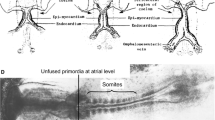Abstract
The initial heartbeat of the chick embryo occurs shortly after the first day of incubation1,2. The pacemaker of this beat originates in the region of the primitive heart destined to become sinoatrial tissue in the adult3. Individual cells isolated from the atrial and ventricular portions of the embryonic heart are also capable of beating spontaneously at this stage4,5. However, the intrinsic activity of these cells gradually diminishes from about day 7 until day 21 when the chick hatches5. We have investigated these changes in automaticity by measuring membrane pacemaker currents with the voltage-clamp technique from aggregates of cells prepared from 7-, 12- and 17-day-old chick embryo cardiac ventricle. We report that there is a voltage and time dependent conductance at 7 days which is markedly reduced by 17 days. The reduction of this pacemaker current parallels the decrease of spontaneous activity in these preparations.
Similar content being viewed by others
References
Sabin, F. R. Carnegie Contr. Embryol. 6, 61–124 (1917).
Barry, A. J. exp. Zool. 91, 119–130 (1942).
Van Mierop, L. H. S. Am. J. Physiol. 212, 407–415 (1967).
Cavanaugh, M. W. J. exp. Zool. 128, 573–589 (1955).
DeHaan, R. L. Devl Biol. 23, 226–240 (1970).
Sachs, H. & DeHaan, R. L. Devl Biol. 30, 233–240 (1973).
DeHaan, R. L. Devl Biol. 16, 216–249 (1967).
Nathan, R. D. & DeHaan, R. L. Proc. natn. Acad. Sci. U.S.A. 75, 2776–2780 (1978).
Connor, J. A. & Stevens, C. F. J. Physiol., Lond. 213, 1–19 (1971).
DeHaan, R. L. & Fozzard, H. A. J. gen. Physiol. 65, 207–222 (1975).
DeFelice, L. J. & DeHaan, R. L. Proc. IEEE Spec. issue 65, 796–799 (1977).
Clay, J. R., DeFelice, L. J. & DeHaan, R. L. Biophys. J. 28, 169–184 (1979).
Clapham, D. E. thesis, Emory Univ. (1979).
Noble, D. & Tsien, R. W. J. Physiol., Lond. 195, 185–214 (1968).
Shrier, A., Clay, J. R. & DeHaan, R. L. Biophys. J. 25, 299a (1979).
Hodgkin, A. L. & Huxley, A. F. J. Physiol., Lond. 117, 500–544 (1952).
McAllister, R. E., Noble, D. & Tsien, R. W. J. Physiol., Lond. 251, 1–59 (1975).
Author information
Authors and Affiliations
Rights and permissions
About this article
Cite this article
Shrier, A., Clay, J. Pacemaker currents in chick embryonic heart cells change with development. Nature 283, 670–671 (1980). https://doi.org/10.1038/283670a0
Received:
Accepted:
Issue Date:
DOI: https://doi.org/10.1038/283670a0
- Springer Nature Limited
This article is cited by
-
In Vitro Monitoring of Live Cardiomyocytes Dynamics by a Scanning Near Field Optical Microscope Setup
Optical Review (1999)
-
Comparison of the pacemaker properties of chick embryonic atrial and ventricular heart cells
The Journal of Membrane Biology (1982)





